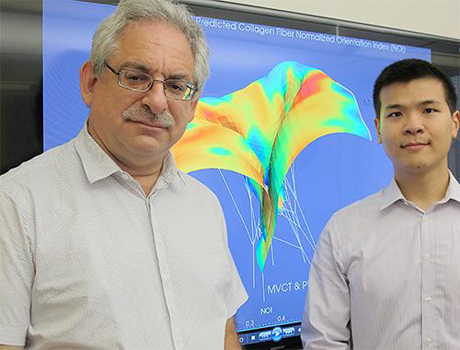The National Institutes of Health is turning to researchers at The University of Texas at Austin to develop computer simulations to improve surgical repair of the heart’s mitral valve, one of the aging heart’s key points of failure.
The NIH has awarded a $6.6 million grant to professor Michael Sacks, director of the Center for Cardiovascular Simulation at the Institute for Computational Engineering and Sciences (ICES) to develop novel, detailed, computer simulations of normal (see ICES video) and diseased heart mitral valves.
 The simulations will help develop more permanent surgical repair solutions for mitral valve disease. Nearly 40,000 Americans — most of them in their 50s or older — have their mitral valve repaired or replaced each year, according to the American Heart Association.
The simulations will help develop more permanent surgical repair solutions for mitral valve disease. Nearly 40,000 Americans — most of them in their 50s or older — have their mitral valve repaired or replaced each year, according to the American Heart Association.
“Current methods to treat mitral valve disease, including annuloplasty rings, don’t last forever and eventually fail,” said Sacks, professor of biomedical engineering in the Cockrell School of Engineering.
Collaborating with laboratory and surgical researchers from The Georgia Institute of Technology and The University of Pennsylvania, Sacks hopes mitral valve simulations will lay the groundwork for more informed surgical methods with better, longer-lasting outcomes for patients with mitral valve disease. The condition is often associated with the regurgitation of blood backward from the left ventricle of the heart to the left atrium, which can cause abnormal heart rhythms and heart failure.
Today, treating mitral valve disease involves reshaping the valve back into a functioning shape with an annuloplasty ring, usually made of a plastic, silicone or metal. However, the flat shape of most rings offers an ill-fitted 2-D solution for what is in reality a complex 3-D structure. The effects of poor repair design introduces abnormal stresses on the valve tissues, which can affect the underlying microstructure of the valve and lead it to fail.
Despite the benefits of repair, 60 percent of patients, those whose mitral valve problems were brought on by ischemic heart disease, have mitral valve regurgitation only three to five years after corrective surgery.
“The reason the mitral valve fails, we hypothesize, is because of how the abnormal stresses affect the underlying cells that lie within the mitral valve tissues. But it’s not the cells that fail; what fails is the organ,” said Sacks. “So our models are multiscale, … and deal with both the microanatomy and the mechanics, from the cells to the leaflet tissues — the entire mitral valve.”
By accounting for the microstructure of the valve in his model, Sacks hopes the simulation can provide a more in-depth understanding of the physiology of the mitral valve and the forces that affect it, in both a normal and post-annuloplasty valve.
To inform his simulations, Sacks is incorporating detailed in-vitro measurements of the mitral valve from collaborators at The Georgia Institute of Technology, and extensive animal studies from collaborators at The University of Pennsylvania. Ultimately, measurements from individuals will be used to create patient-specific mitral valve simulations in the future, said Sacks.
“It’s personalized in the sense that we want to look at the details of the individual patient and their individual anomalies,” Sacks said.
Using the simulations as a guide, Sacks and his collaborators plan to develop and test new annuloplasty ring designs that seek optimal health of the mitral valve at all levels, from cell to organ structure.
If all goes well, Sacks says he hopes that by the end of the five-year grant, the designs will be ready for clinical trials.
This tightly integrated research approach — using computational, laboratory and surgical research concurrently — is a combination that Sacks says will help lead to improved therapies. It also represents a jump for ICES from the institute’s usual role of supporting research into direct device development. Recent advances in computational technology have allowed such simulations not only to become feasible, but also to be fast and robust enough to directly improve patient health, said Sacks.
— Written by Monica Kortsha, of the Institute for Computational Engineering and Sciences
Michael Sacks holds the W.A. "Tex" Moncrief, Jr. Endowed Chair No. 1 in Simulation-Based Engineering and Sciences.







